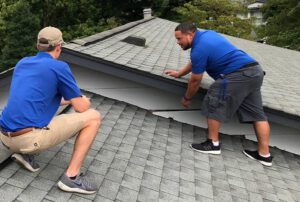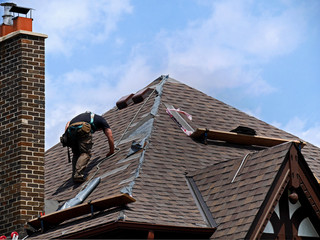A home’s roof is its primary protection against water damage. That’s why it needs to be inspected periodically to make sure it is in good condition. For professional assistance, contact Roofing Colorado Springs.

The inspection looks at the entire structure of the roof, including the soffit, fascia, and gutters, as well as any skylights or masonry chimneys. Inspectors also look for signs of sagging, stains, mildew, or mold.
When a new roof is being installed, the first thing that a roofing contractor needs to check is the condition of the roof deck. If it’s rotting, it can’t hold the weight of the shingles and other materials that will be attached to it. The International Residential Code requires that the shingles be fastened to solid sheathing. This means that the sheathing must be able to support the weight of the shingles and other materials.
The inspector will look at the sheathing to make sure that it is properly nailed and not rotted. He or she will also verify that the sheathing is thick enough for a roof. Some types of sheathing, such as plank sheathing, require a specific thickness to be in compliance with the code.
During this inspection, the inspector will also look at all areas where the sheathing has been cut to accommodate flashing or other items. He or she will also check that kick-out flashing is in place where needed, especially for chimneys.
If the sheathing is not in good condition, the inspector will note that on his or her inspection report. The inspector will also note if the sheathing is being used for an existing roof, in which case it will be required to have a kick-out flashing in accordance with IRC Section R903.2.1.
A professional will also inspect the joists and beams on the inside of the roof, looking for rust or other damage. He or she will also make sure that joists and beams are properly supported by the framing. The inspector will also look for rust on fasteners, metal connector plates, and joists. The inspector will also note whether the joists are properly spaced and the rafters are plumb.
Vents
Many homes have a variety of vents, including gable, soffit, and ridge vents. Each type of vent requires careful inspection to make sure the opening is open and free of obstructions. The home inspector will also check that the prevailing winds are blowing parallel to the vent. If they are blowing across the openings of the ventilation system, the performance of the ventilation system will suffer.
When a roof vent is installed, there must be flashing that covers the opening. The flashing helps keep water from getting into the structure through the gap. Building codes are very strict about this type of flashing, and the inspector will inspect it to see that it is properly installed.
In addition to checking that all the vents are open and in good condition, the home inspector will also look for adequate attic ventilation. He will take the temperature of the attic space and check that bathroom and kitchen exhaust fans vent out the roof. Many older homes did not have this, and the result is that moisture in the attic causes mold problems.
The attic is a dangerous place, and the home inspector will wear a hard hat and safety glasses and carefully walk around the attic beams. He will be looking for any signs of active leaks, such as daylight shining through the attic ceiling or dripping water spots on the ceiling below the attic or in the attic itself, and will also inspect the attic insulation for sagging, looseness, gaps, or other problems. The inspector will also look for the condition of any penetration seals on ductwork, chimneys, plumbing vent pipes, and media installations such as cable TV or satellite dishes.
Flashing
Many elements of construction go unnoticed, but the flashing that prevents roof leaks is not one of them. This thin protective layer is installed in areas where the walls of a building meet the roof or where structures like chimneys, vents, and skylights intersect with the roof. It also protects against leaks around those structures and creates an airtight seal in other crevices that might otherwise seep into the structure.
It is most often made of copper, aluminum, or galvanized steel. If not properly installed at the time of initial roofing installation, flashing can quickly deteriorate and lead to the leaking that characterizes so many roofing failures. When re-roofing a home, it is generally advisable to replace all of the flashing. But in some cases, a professional roofer might choose to reuse the old flashing if it looks like it is in good condition and would still serve the purpose of directing water away from seams and joints.
During your roof inspection, make sure you check the exposed flashing for any signs of deterioration, particularly in the areas around vents, pipes, chimneys, and skylights. Leaks at these points can penetrate your home’s exterior and even the inside of your attic. Look for areas of flashing that appear to be peeling away from the wall or looking severely corroded.
Roofers install various types of flashing to ensure a watertight barrier. Some are designed to be exposed, while others are embedded. Examples include step flashing, which consists of short pieces of metal that overlap the flashing course below them. This is often found in chimney stacks on pitched roofs and along the edges of dormer windows, which jut out from exterior walls. There is also wall flashing, which is embedded in the interruptions in a wall, such as doors or windows, to prevent water ingress and direct any that does enter back outside.
Soffit
A soffit is the “skin” that covers the eave of your roof and serves both an aesthetic and functional purpose. Aesthetically, it adds character to your home and can be painted in a variety of colors to match your trim or siding. Functionally, it protects the rafters, or your roof’s support beams, from the elements. Without a soffit, the rafters would rot over time and, if left unchecked, could cause mold to invade your home. Both of these are very expensive to repair.
In addition to protecting the rafters, the soffit also helps keep pests like squirrels and bees out of your home. It also provides ventilation for your attic. If your soffit is not properly vented, it can lead to moisture and mold issues, resulting in water leaks from the roof into the attic. In addition, clogged soffit vents can prevent air flow between the roof and the attic, leading to ice dams and other issues.
Soffits can be made from a variety of materials, including wood, vinyl, and aluminum. However, James Hardie fiber cement soffits are recommended, as they do not rot and can withstand hot climates.
During your roofing inspection, the inspector will check for damage to the soffit and fascia, including peeling paint, cracks, rotting or warping, and other signs of damage. In addition, the inspector will assess if soffit vents are clogged or missing. If necessary, he will recommend that the soffit and fascia be repaired or replaced. If not repaired or replaced promptly, it could result in further damage to your roof and shingles. It is also a good idea to install removable soffit vents on balconies to allow for rapid temperature and vapor equalization, preventing mold, rot, and insect infestation.
Shingles
The roof shingles are the outermost layer of your home’s shelter. They are affixed to the deck with nails or glue and then covered with granules, a protective barrier from the sun’s damaging UV rays.
Your inspector will walk around the house, checking for popped nails, cracked caulk, and other signs of wear and tear on your shingles. They will also look for shingle edges that have lifted or curled and moss or algae stains.
As the material inspection continues, your inspector will check the flashing that is placed wherever shingles butt up against other surfaces or each other, such as at chimneys or in open valleys. The flashing is a vital piece of the roofing system to keep rain out of your house, so your inspector will make sure that it isn’t rusted and that all of the pieces are still in place.
They will also inspect the eaves and gutters to see if there is any water leaking or overflowing. They will also look for rust on metal gutter downspouts and check the condition of the soffit, including making sure that it is solid and not rotting or allowing water to penetrate.
An interior inspection is also part of the roof inspection, since leaks from a bad roof will ultimately damage the inside of your home. Your inspector will examine ceilings, attics, and walls throughout your home for signs of water stains, mold, or other problems that would indicate that the roof is not working as it should. They will check for proper attic ventilation, which is crucial to extending the life of your shingles. They will also check the rubber boots and seals around vent pipes to make sure they are in good condition.

